Yunnan Province| Comfortable, leisurely and romantic, there is a life called Dali
--There are countless white sea vegetable flowers ("aquatic poplar flowers") on the Erhai Lake

--The majestic three towers of Chongsheng Temple are built under blue sky and white clouds

--Xizhou Ancient Town with clear skies and simple nature

--Fresh, quiet and leisurely time in the double corridor

---Shaxi Ancient Town with few primitive natural people and exquisite

--Beilong Village Pioneer Bookstore

--The source of the Red River is difficult to find a lonely mountain

[Wind and Snow Moon-Dali]
Cangshan has no ink for thousands of years, and Erhai has no strings for forever. Most of Dali's travel time revolves around Cangshan and Erhai. The wind from Xiaguan blows flowers on Shangguan, and the moon on Erhai shines on Cangshan and snow. In Dali, the scenery is beautiful, poetry and distance are never just words. It's like having a magnificent dream that makes people willingly indulge in it ~

--Cycling around the Erhai Lake
The most must-miss experience when traveling in Dali is of course riding around the Erhai Lake. Rent a bicycle and enjoy the fresh air and the taste of freedom on the winding Erhai Lake Ecological Corridor. You can be fast, you can also be slow, follow your nature, and be free.


The clear lake water and the blue sky are often flocks of birds flying past. There are patches of flowers, green lawns and tall forest trees on the roadside. People looked at each other and smiled, walking through the beautiful life pictures of Dali. On one side is Canshan and Erhai Lake, and on the other side is the elegant and simple Bai folk residential buildings. Romance comes from all directions and meets you.
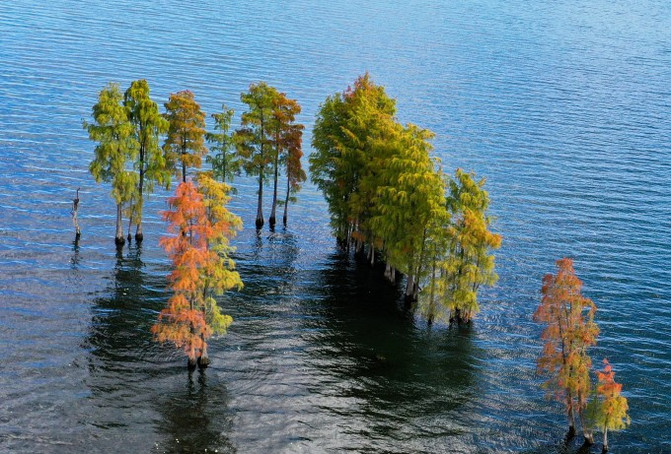
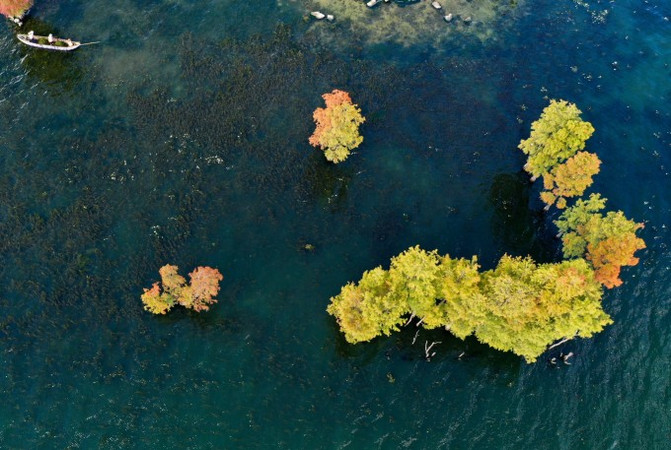
The metasequoia trees in the Erhai Lake are tall and colorful, with gradient colors of red, orange, yellow and green, which are pleasing to the eye. They are the appearance of autumn and the color of Dali.


The legendary "aquatic poplar flower", also known as sea cauliflower, can be seen in the Erhai Lake in Dali or Lugu Lake in Lijiang. This is an aquatic plant that requires extremely high water quality. However, there are countless sea cabbage flowers floating on the Erhai Lake, which are white and bright, which shows that the ecological environment of the Erhai Lake is really good.


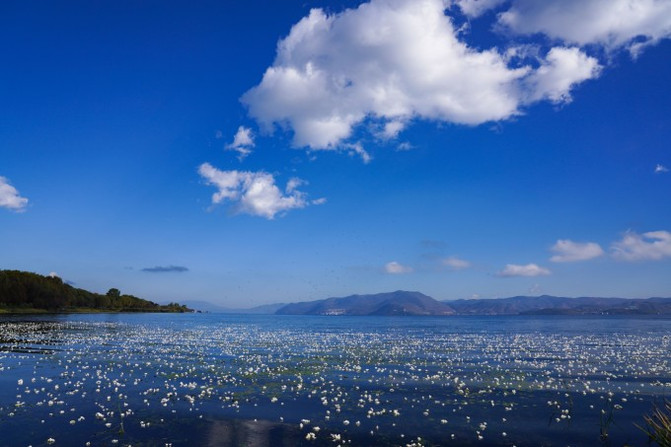
Enjoy Metasequoia at Longkan Wharf. This is a famous check-in spot for Internet celebrities in Dali. Many people take pictures here to take wedding photos. In fact, the Erhai Ecological Corridor is full of beautiful scenery. Every turn has a different surprise. Every flower and grass are fascinating.



--Three pagodas of Chongsheng Temple
The green mountains are stone levels, shining with reverence. The three pagodas of Chongsheng Temple are magnificent and magnificent.
The Three Towers of Chongsheng Temple are also a very famous scenic spot in Dali. They are located 1.5 kilometers northwest of the ancient city of Dali, facing Cangshan Yingle Peak in the west and Erhai Lake in the east. It is the largest ancient temple in Dali's history. During the Fengyou period of Nanzhao, there were thousands of temples. During the Dali Dynasty, it was a royal temple.


The three pagodas of Chongsheng Temple consist of three pavilions, one big, two small ones. The big tower is also known as Chihiro Tower. Local people call it the "Wenbi Tower". It has a height of 69.13 meters, a bottom of 9.9 meters, and a total of 16 levels. It is a typical dense eaves hollow square brick tower in Dali area.


The north and south towers are both ten-level and 42.17 meters high. They are octagonal hollow brick towers with dense eaves. There are three towers standing on a tripod, with Chihiro Tower in the middle, and two small towers guarding the north and south, making it majestic and magnificent.
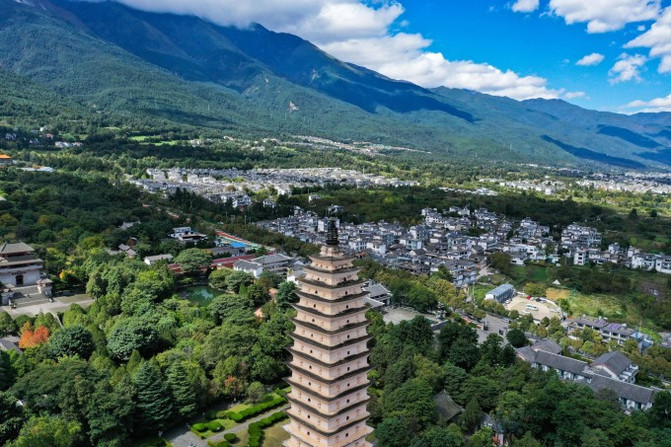

The entire scenic area is quite large. After checking in, the first thing you see is the three towers. You can walk directly to visit the three towers, or you can take the scenic bus to the highest point of the Daxiong Hall and visit it from top to bottom.


The entire temple is built upwards in a stepped manner, solemn and majestic. The tour time of the entire scenic area is about two hours. You can find a tour guide, listen to the explanation, and learn about the history and culture of the temple and the three pagodas.


--Dali City Xizhou
The time in Xizhou melts in distant mottled memories. The ancient and mysterious Jiama depicts traces of history.
Xizhou Town is located in the north of Dali City, bordering Cangshan Mountain in the west and Erhai Lake in the east. It was called "Dali City" during the Sui and Tang Dynasties and was one of the "Ten Peaks" during the Nanzhao period. It is also the hometown of the movie "Five Golden Flowers". It is also a famous historical and cultural town and one of the key overseas Chinese towns in Yunnan Province. It is a famous historical and cultural town of the Bai people with a history of more than a thousand years.


In everyone's impression, what Xizhou may think of is the endless rice fields, but in fact, this season, almost all the rice in the fields has been harvested. However, Xizhou is more than that simple...


"It is customary to draw a divine Buddha statue on paper, paint it with red and yellow colors, and sacrifice it to it, and burn it immediately after it is finished. It is called a horse. This paper is the basis for gods and Buddhas
Yi, it seems like a horse." Early records of Jiama can be found in many documents such as "Tianxiang Lou Ou De" written by Yu Zhaolong, a native of the Qing Dynasty. from it
The original Han settlement was introduced to Jiama in Yunnan through cultural phenomena, and the beliefs, culture, and customs in this complex and diverse land.
Infiltration and integration have formed the "Yunnan Jia" that is still frequently used in folk life in Kunming, Dali, Chuxiong, Baoshan and other areas
horse."

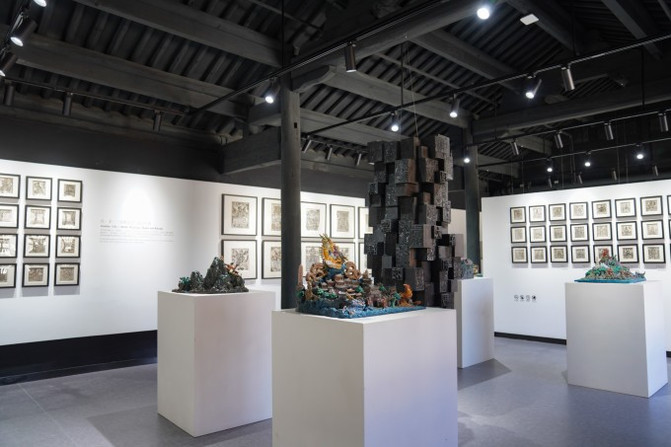
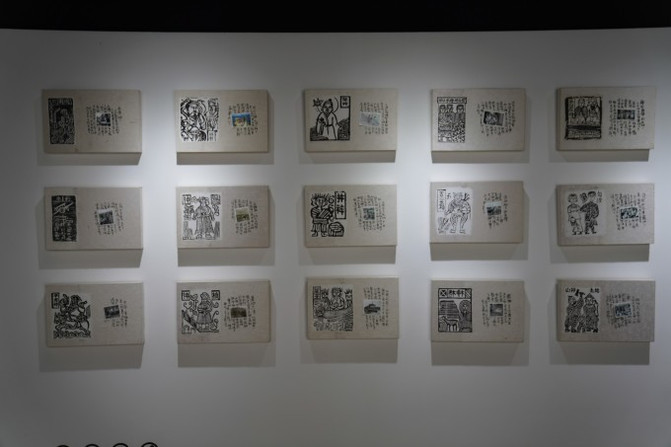
Each horse is a key that opens the door to the fantasy world. Turning the keyhole of faith, we have the opportunity to cross the boundaries of imagination and become short-lived time travelers in Xizhou. Through woodblock prints, you can travel through thousands of years and see the traces of history famous.



--Man Time Double Corridor
It is said that the scenery of Dali is in Canger, and the scenery of Canger is in Shuanglang.
Shuanglang Town is located at the northeastern end of Dali City and on the northeastern bank of Erhai Lake. It is known as the first town in Canghai scenery. It is also the location of Nanzhao Style Island. The town is surrounded by mountains on three sides and faces the sea on one side. Jumping on the 19th Peak of Cangshan Mountain in the west, facing the vast blue waves of the Erhai Lake, the Buddhist resort of Jizu Mountain in the east, and Xiaoputuo in the south.
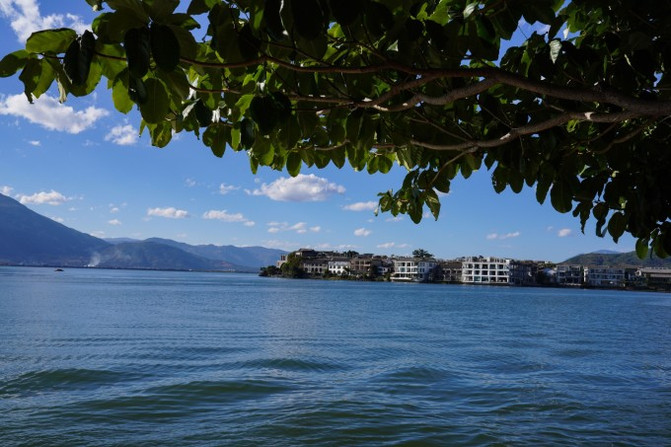

When you spend your time in Shuanglang, you can deeply understand the poetry and the artistic conception of the distance. Find a coffee shop, sit by the water, read a good book, eat delicious food, even if you don't do anything and stay quietly, it is a kind of enjoyment.



Dali has too much poetry, quiet double corridors, long time, comfortable in Dali.
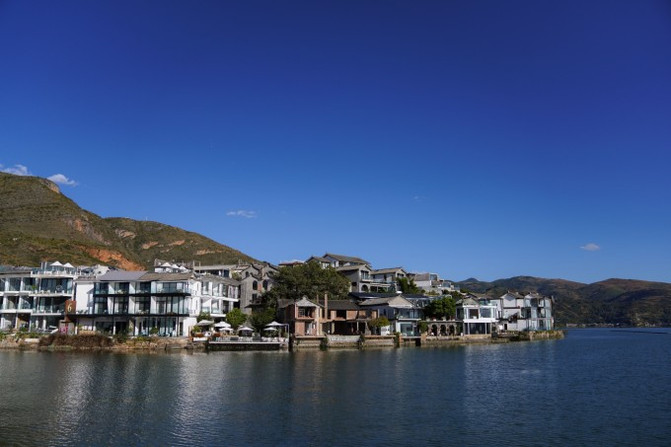

[Xinyin Ancient Town-Shaxi]
The big ones are hidden in the city, the small ones are hidden in the wild, and the heart is hidden in the Shaxi River.
Shaxi is a place where time can flow back. Time does not move forward here, but recedes back, all the way back to the distant Caravan era ~


Away from the hustle and bustle of the city, the depth of the history of the ancient road. When you come to Shaxi, you will feel a sense of belonging, surrounded by mountains and rivers, and dreaming of countryside.
The ancient tea-horse road has a long history. Fortunately, there are witnesses guarding this simple land. The big locust trees on Sifang Street, the simple and solemn Xingjiao Temple, and the ancient stage with high stars slowly tell the story of the ancient Shaxi.


Shaxi is an ancient town with a long history of thousands of years, dating back to the Spring and Autumn and Warring States Period more than 2400 years ago. The ancient tombs of Aofengshan and the Huacongshan Copper Mine Site in the east of Shaxi silently tell us that more than 400 years BC, Shaxi formed a bronze smelting and production base centered on the Heiyan River. At that time, the ancestors of Shaxi had a high level of bronze smelting technology and became one of the birthplaces of Yunnan bronze culture.
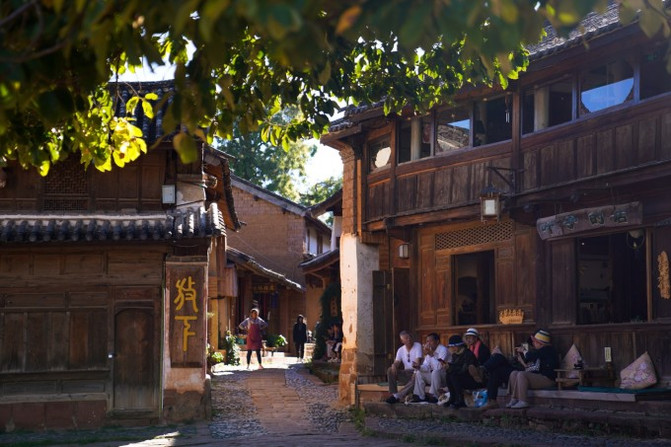

Sideng Sifang Street is the soul and core of Shaxi, and is the place for commercial transactions in Shaxi. It integrates temples, ancient stages, shops, stone streets, century-old trees, ancient alleys and roads, and village gates. It has been praised by experts from the World Memorial Building Foundation as "the only surviving ancient market on the ancient tea-horse road"!

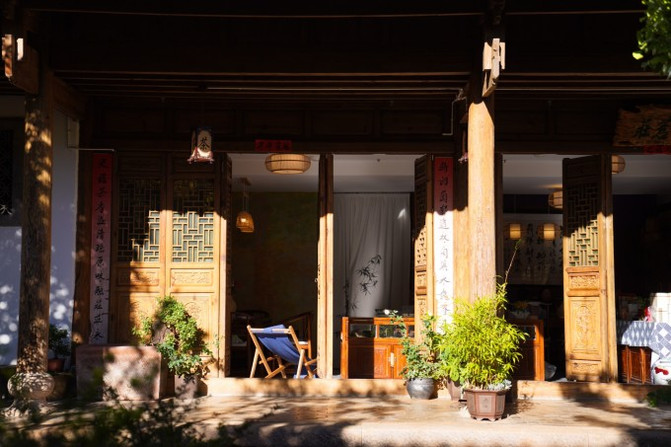
Historically, Sideng Sifang Street was called "Nantang". In the late Ming Dynasty, it was named after Xingjiao Temple, so it was called Sideng Sifang Street. Temple refers to Xingjiao Temple; Deng is the Bai language, meaning place. Located next to Xingjiao Temple, there is a square street. This is the origin of the name of Sideng Sifang Street.

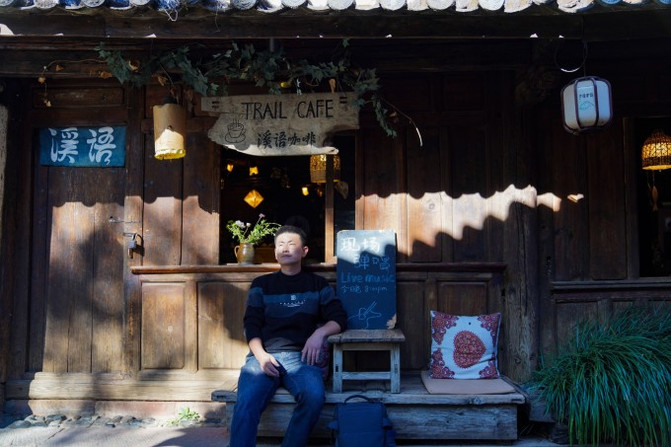
With white walls and blue tiles in villages and undulating rice fields, Shaxi Yujin Bridge spans the long river of history, extraditing past civilization to both sides of the river. In Shaxi, life is not only one direction, and romance is not only one way. On the way to pursue wind and light, you leave touching moments.


Beilong Village, not far from Yujin Bridge, has a Pioneer Bookstore. It is also a relatively unique place in the local area. It is more suitable for taking photos and checking in. There are a wide variety of books. Find a corner and flip through a good book, and you can spend most of the slow time.



[Dream back to Nanzhao-Weishan]
To the south of western Yunnan, in a corner of Canger, this is the source of the Red River and Weishan, the ancient capital of Nanzhao. The last stop on the trip to Dali is the ancient city of Weishan.
Weishan has a splendid culture. It is the birthplace and ancient capital of Nanzhao State, an important town on the ancient tea-horse road, and a sacred place for the Yi people to seek their roots and worship their ancestors. It was named a "Famous Literature State" by the imperial court in the Qing Dynasty. There is a well-preserved ancient city of Weishan, which is more than 600 years old, 59 cultural relics protection units at all levels, a national-level forest park, a famous Taoist mountain, and a major road for bird migration. It is the birthplace of the Red River.


Smoke curled in the rising sun, and the sunset turned into Qi in the sunset. The ancient city of Weishan does not have a strong commercial atmosphere, no lively and bustling prosperity, but more of a simple fireworks atmosphere.

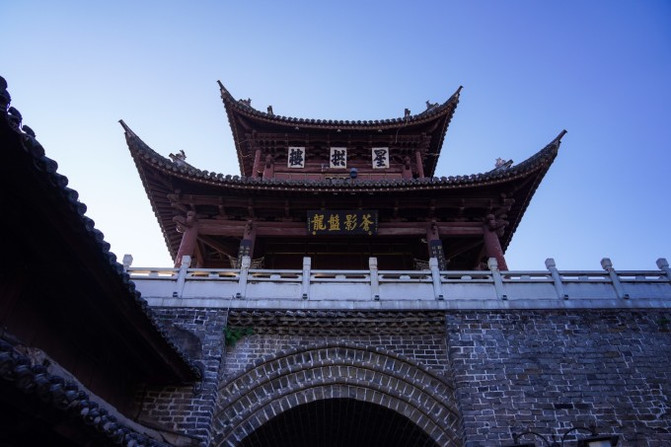

Strolling through the ancient city, you will find the streets and alleys, scattered academies, and delicious food everywhere. The faint ancient meaning and strong cultural atmosphere are reflected in the genial sunshine. From the ancient color of bricks and tiles, the dream of returning to Nanzhao is reflected in every corner.


Weishan Confucian Temple is located in the west gate of the county. It was built during the Hongwu period of the Ming Dynasty and was built by the local prefect of the Zuo family of Menghua Prefecture. It has undergone many renovations and expansions during the Tianshun and Wanli periods of the Ming Dynasty and Shunzhi and Kangxi periods of the Qing Dynasty, forming a certain scale. The entrance fee is 5 yuan, so it is still very worth visiting.


The architectural forms of Confucian temples across the country are mostly similar. On the central axis of the courtyard are Panchi, Bridge Lingxing Gate Shifang, Dacheng Gate, Dacheng Hall, Yanta Square, Chongsheng Temple, and Zunjing Pavilion. On the east and west sides, there are also famous official temples, festival filial piety temples, Shepu, etc., a total of 13 courtyards.
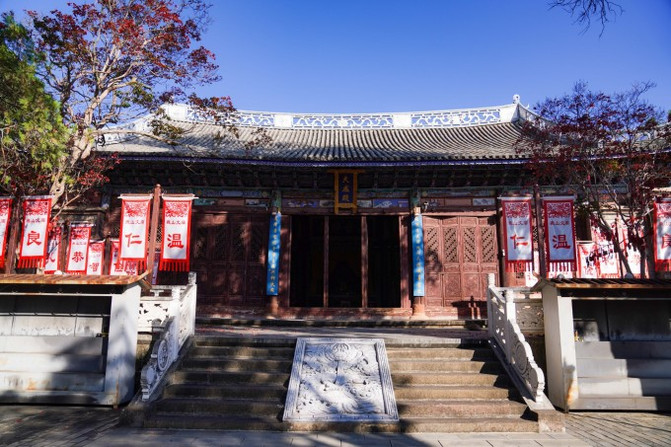

The ancient city has a history of more than 600 years. The city is as good as the seal. The streets are 2 kilometers long from north to south and 1 kilometer long from east to west. There are 24 streets, 16 alleys, and 2 roads in the city. South Street, North Street, Risheng Street and Yuehua Street are the main north-south roads. The street is 6 meters wide and the streets and alleys are crisscrossed. The streets and buildings along the streets retain the chessboard pattern and style of the Ming and Qing Dynasties.



Weishan Mengyang Park is commonly known as the Grand Park. The east of the park used to be the Yanta Square and Chongsheng Temple of the Confucian Temple. There are many ancient trees in the park, among which the cultural courtyard is relatively complete. Many citizens and tourists walk and read books here. It is a good place for leisure and entertainment.


Wenhua Academy, named after its location at the foot of Wenhua, is located in the northeastern corner of the ancient city. The academy covers an area of more than 4000 square meters and consists of a main gate, second gate, panchi, arch bridge, Yanta Square, Kuixing Pavilion, library building and front and backyard wing rooms. The gate is built of bluestone in the style of three archways, and the Kuixing Pavilion is a double-eaves and hill-like building with a width of five rooms. The lower level is surrounded by corridors, and the upper and lower eaves are surrounded by brackets. The ancient buildings still preserved today include Yanfang Tower, Kuixing Pavilion, Library Building and some wing rooms.

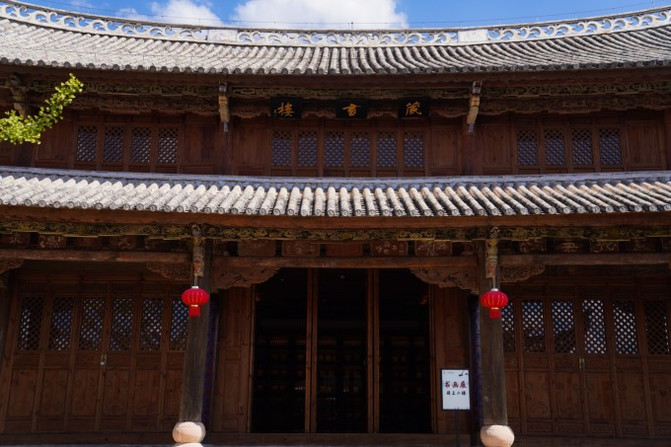
The Yuhuangge Building Complex is located on the north side of Wenhua Academy. It was built in the Ming Dynasty. It was destroyed during the Xiantong period of the Qing Dynasty and rebuilt during the Guangxu period. It mainly consists of the gate, front hall, middle hall, rear hall, four entrances, three courtyards and wing rooms. The terrain of one courtyard is higher than the other. The gate is a three-bay archway style single-eaves Xieshiding hilltop building. The front eaves are equipped with Ruyi bucket arches, the rear eaves are made of hanging columns, and the flying eaves are angled. The structure is rigorous and the workmanship is fine. The two gable walls are decorated with brick blockhouse bucket arches, which is ornate.



[Tail]
If you are confused first, if you can't find your way now, come to Dali!
Let Cangshan Erhai Lake heal your "injuries", and let the famous literature city take you into the slow time you yearn for.
The wind and the snow are in Dali ~
Previous Article:There are 20 domestic travel destinations worth visiting, and those who have visited 7 of them can be regarded as travel masters
